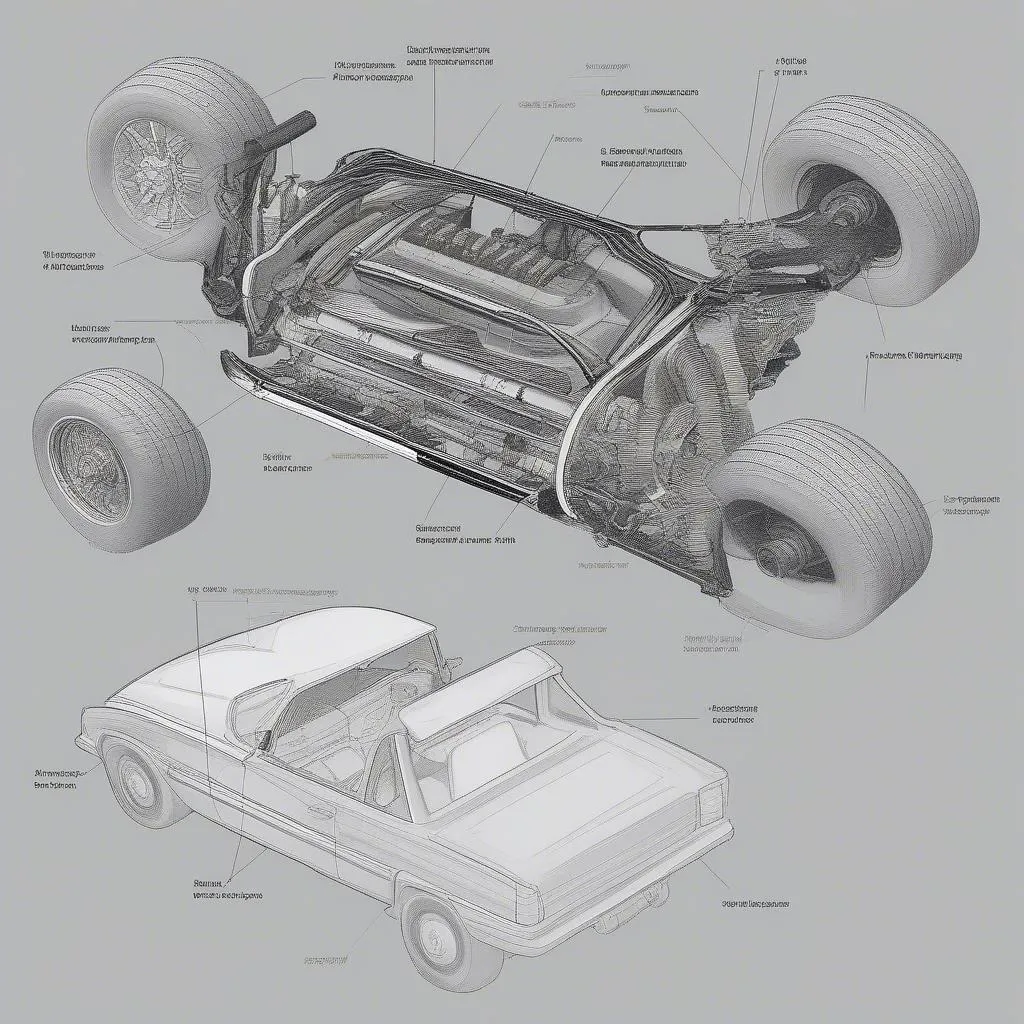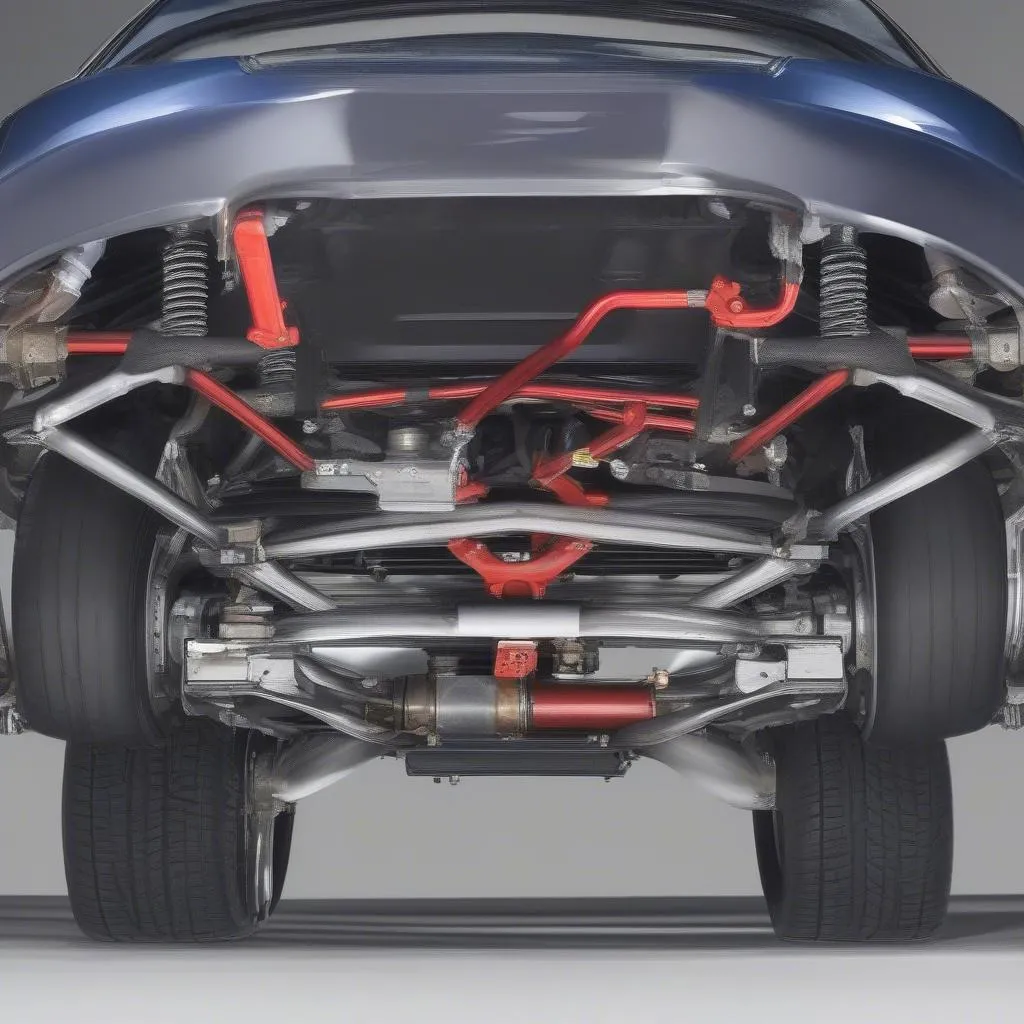Have you ever looked under a car and wondered what all those parts are? It can be a confusing maze of pipes, wires, and metal, especially if you’re not a seasoned mechanic. But understanding the car undercarriage is crucial for diagnosing problems, performing maintenance, and even appreciating the engineering marvel that is your car.
In this guide, we’ll delve into the intricacies of the car undercarriage diagram, helping you decipher its components and their functions. We’ll also explore some common questions and concerns related to the undercarriage, providing you with the knowledge to become a more informed car owner.
Understanding the Car Undercarriage Diagram: A Deeper Dive
The car undercarriage diagram, often referred to as the chassis diagram, provides a visual representation of all the components located beneath the car’s body. This includes the suspension, exhaust system, fuel lines, brake lines, and other vital components that support the car’s structure and functionality.
The Importance of a Clear Diagram
A comprehensive undercarriage diagram is essential for several reasons:
- Problem Diagnosis: When a problem arises in the undercarriage, a diagram allows mechanics to pinpoint the issue quickly and efficiently.
- Maintenance and Repairs: A clear diagram helps mechanics locate specific components for maintenance and repair, minimizing downtime and unnecessary work.
- Modifications and Upgrades: Car enthusiasts who plan to modify or upgrade their vehicles often refer to the undercarriage diagram to understand the layout and identify potential clearance issues.
- Safety Inspection: When inspecting a used car, checking the undercarriage with the aid of a diagram can help identify any signs of rust, damage, or potential problems.
Common Components Depicted in a Diagram:
- Suspension System: The suspension is responsible for absorbing bumps and providing a smooth ride. The diagram will showcase components like struts, shocks, springs, control arms, and sway bars.
- Exhaust System: The exhaust system carries away harmful gases from the engine. The diagram will show the exhaust manifold, catalytic converter, muffler, and tailpipe.
- Fuel System: The fuel system delivers fuel from the tank to the engine. The diagram will depict the fuel lines, pump, filter, and injectors.
- Braking System: The braking system brings the car to a stop. The diagram will highlight components like brake calipers, rotors, pads, lines, and master cylinder.
- Steering System: The steering system allows the driver to control the car’s direction. The diagram will show the steering rack, tie rods, and steering column.
- Other Components: Other components might include the differential, driveshaft, axles, and various mounting points.
Demystifying the Car Undercarriage: A Real-World Perspective
Let’s bring this concept to life with a story. Imagine you’re driving down a bumpy road in your 2019 Ford Mustang, and suddenly you hear a clunking sound coming from the front of the car.
You pull over, and you notice some fluid dripping from the undercarriage. What do you do?
This is where an undercarriage diagram comes in handy. By referencing the diagram, you can identify the potential source of the leak and understand the possible cause of the clunking sound.
For instance, if the fluid is red, it could be brake fluid, indicating a problem with the brake system. If the clunking is accompanied by a loss of steering control, the problem could be related to the steering rack or tie rods.
 Car Undercarriage Diagram
Car Undercarriage Diagram
Finding a Car Undercarriage Diagram: Your Guide to the Road Ahead
You might be wondering, “Where can I find a car undercarriage diagram?”
- Your Owner’s Manual: Many modern car owner’s manuals include detailed diagrams of the undercarriage.
- Online Resources: Numerous websites like Tech Car USA (https://techcarusa.com/names-of-panels-on-a-car/) and [Your Website Name] offer comprehensive diagrams for various car models.
- Repair Manuals: Repair manuals specific to your car model often include detailed undercarriage diagrams with explanations of each component.
- Automotive Forums: Forums like [Forum Name] can be a great place to find diagrams and advice from other car owners and mechanics.
Frequently Asked Questions About Car Undercarriages:
Q: What is the difference between the front and rear undercarriage?
A: The front undercarriage is responsible for the car’s steering and braking, while the rear undercarriage primarily focuses on providing stability and traction.
Q: What should I look for when inspecting the undercarriage?
A: Inspect for rust, leaks, damage, loose components, and signs of excessive wear and tear.
Q: Can I do basic undercarriage maintenance myself?
A: Yes, you can perform some basic tasks like cleaning the undercarriage and checking for leaks. However, for major repairs, it’s best to consult with a professional mechanic.
Q: Why is the undercarriage so important?
A: The undercarriage is crucial for the car’s stability, performance, and overall safety. It protects the vital components from damage and wear.
Conclusion: Embracing the Undercarriage Journey
Understanding the car undercarriage is like learning a new language, one that speaks to the car’s inner workings. By deciphering the diagram, you gain insights into the complex systems beneath your car, empowering you to make informed decisions about maintenance, repairs, and even modifications.
Remember, it’s not just about the parts; it’s about the story they tell.
 Car Suspension
Car Suspension
Don’t hesitate to reach out to our expert technicians at Tech Car USA. We are available 24/7 to help you troubleshoot any problems you encounter with your car’s undercarriage. We can also assist you with the setup of diagnostics tools and software for a smoother and more efficient experience. Contact us via Whatsapp at +84767531508.
Let’s keep your car running smoothly, one undercarriage component at a time!
Feel free to share your thoughts and questions in the comments below.